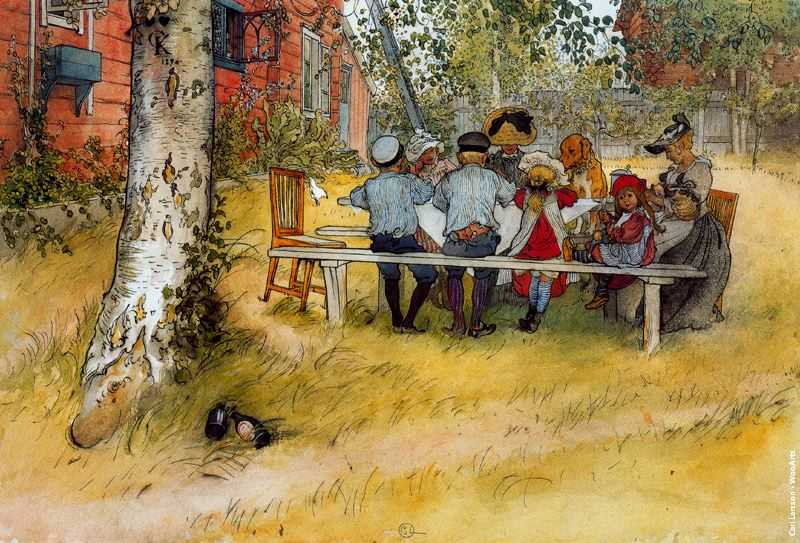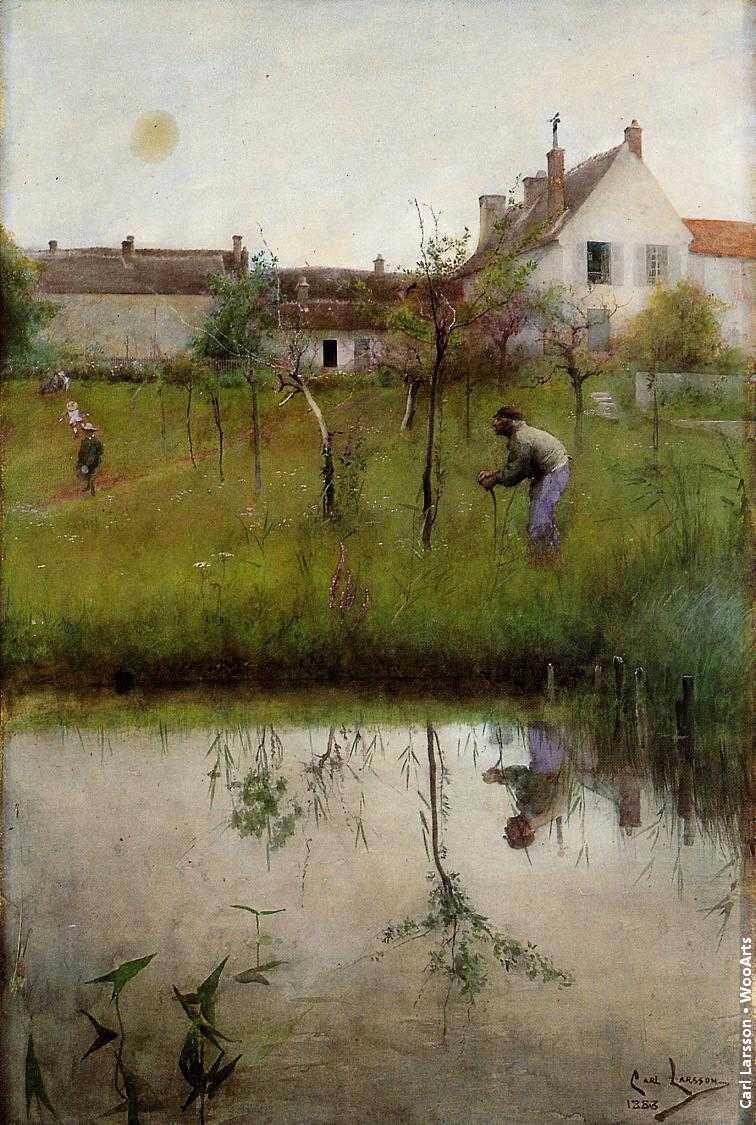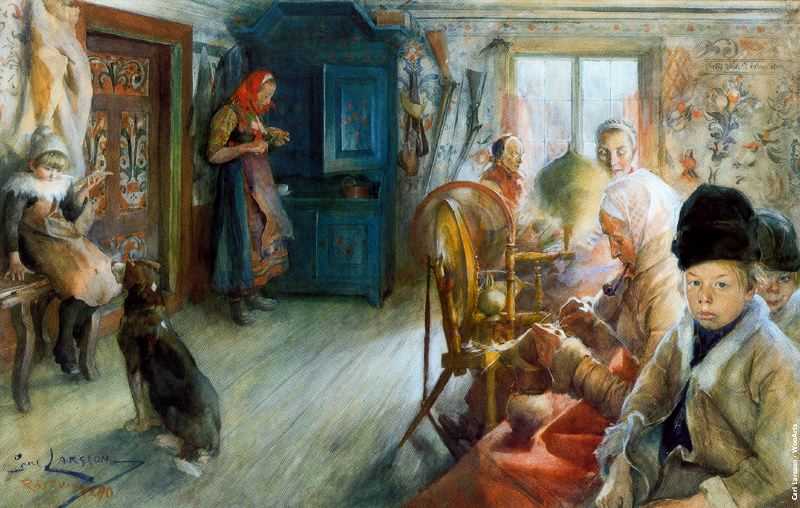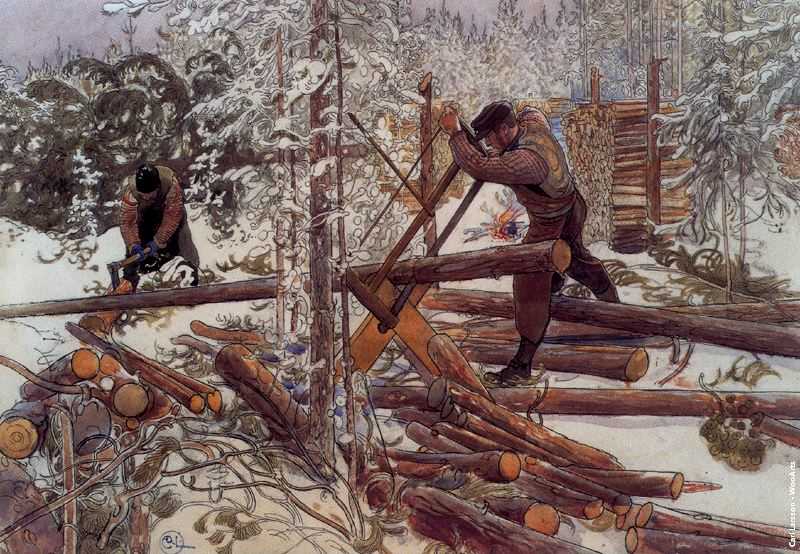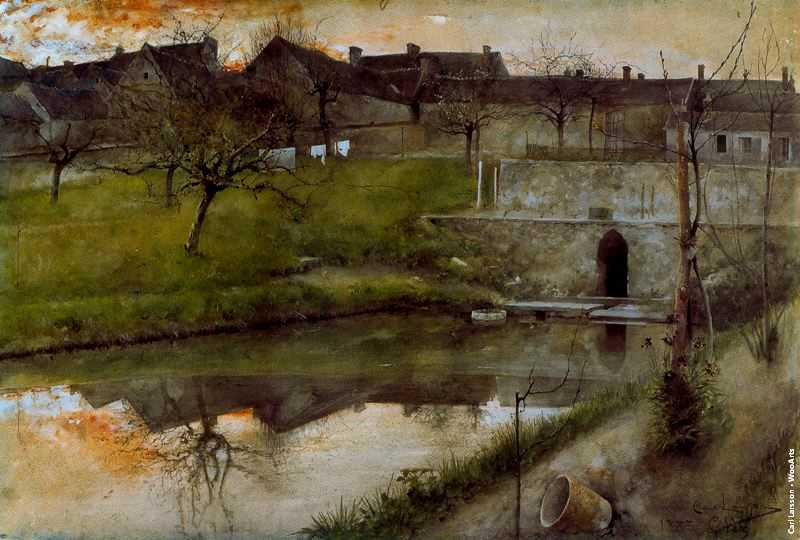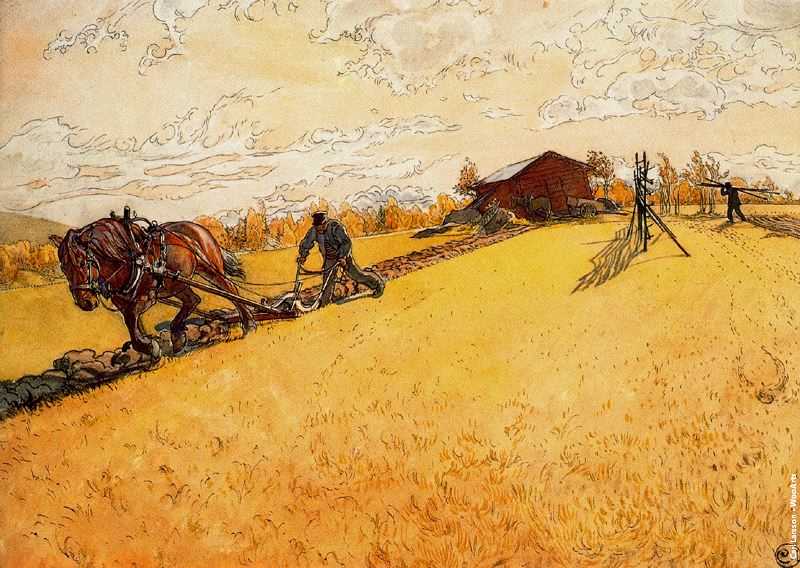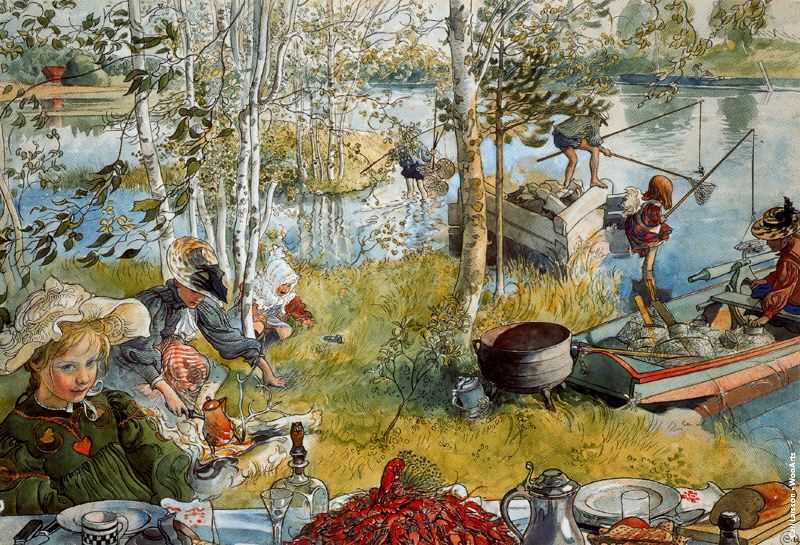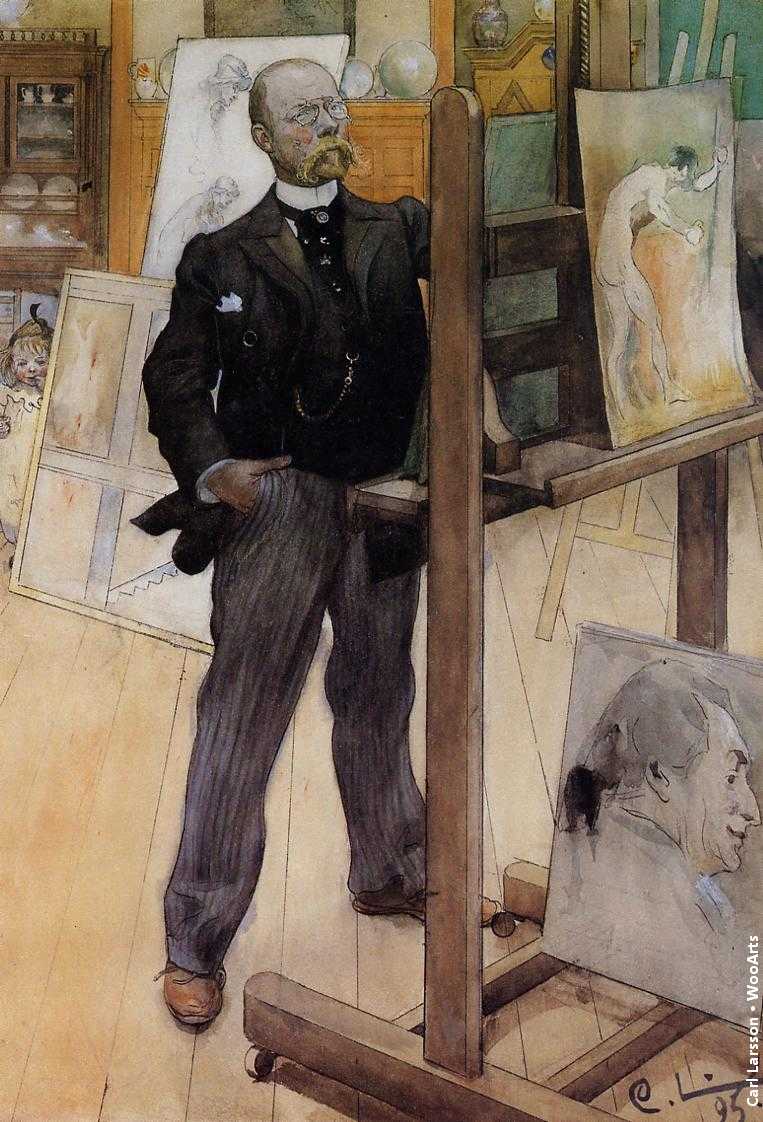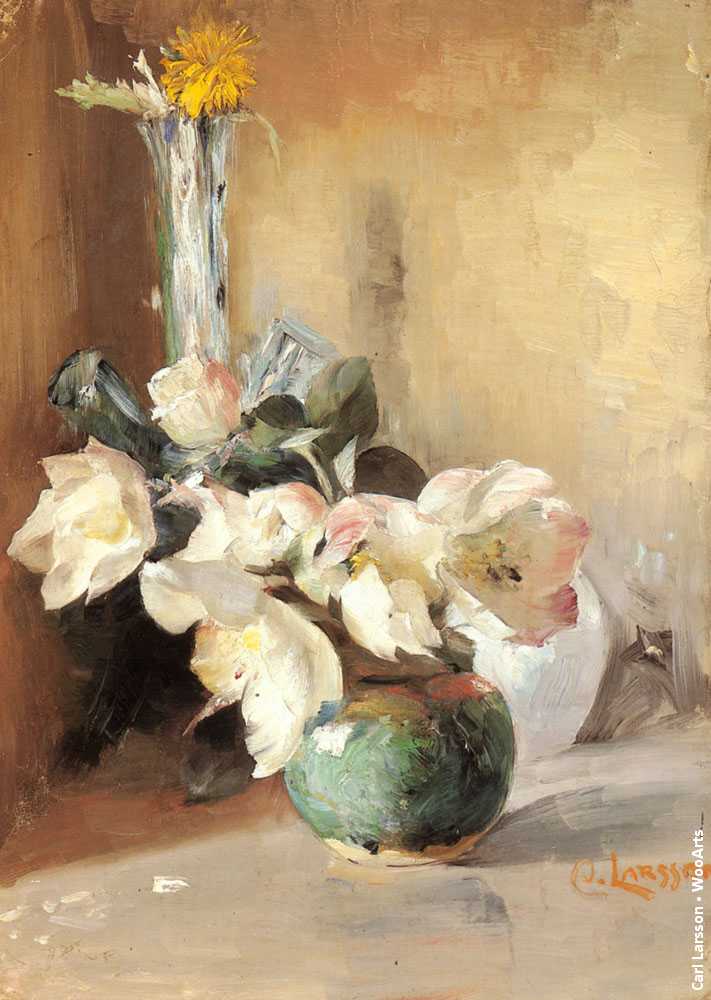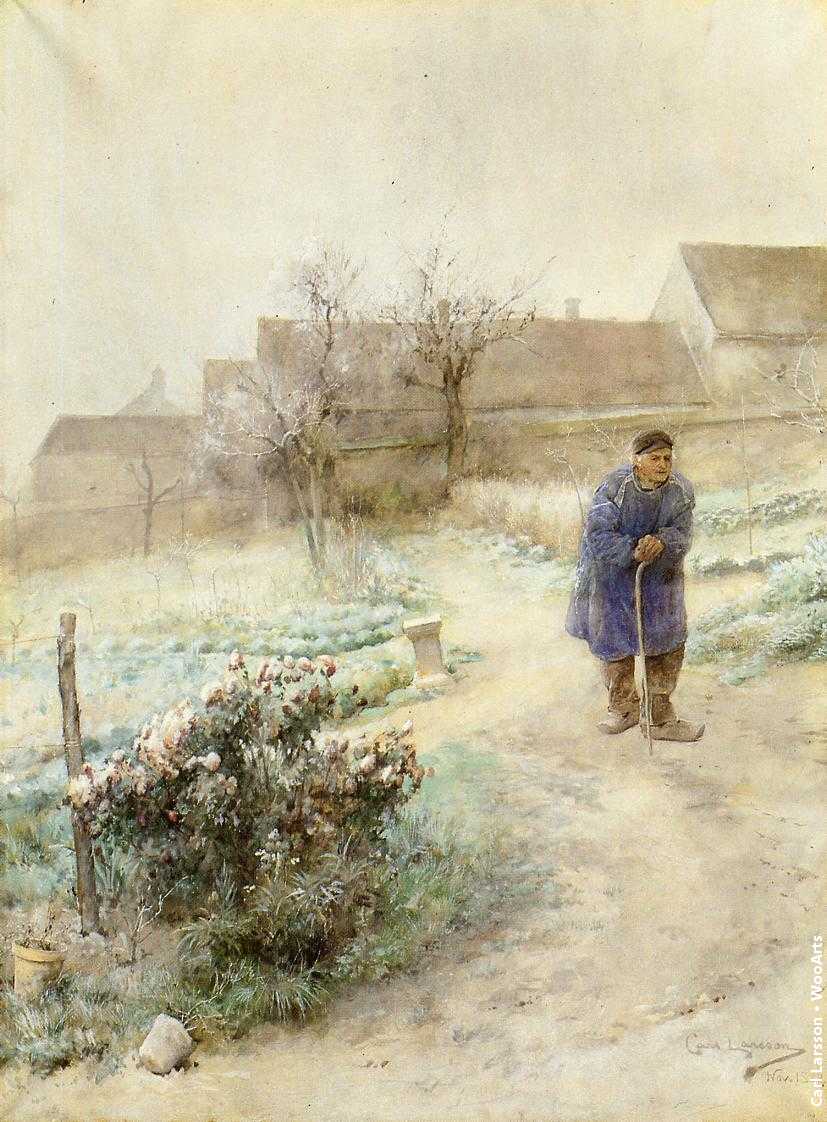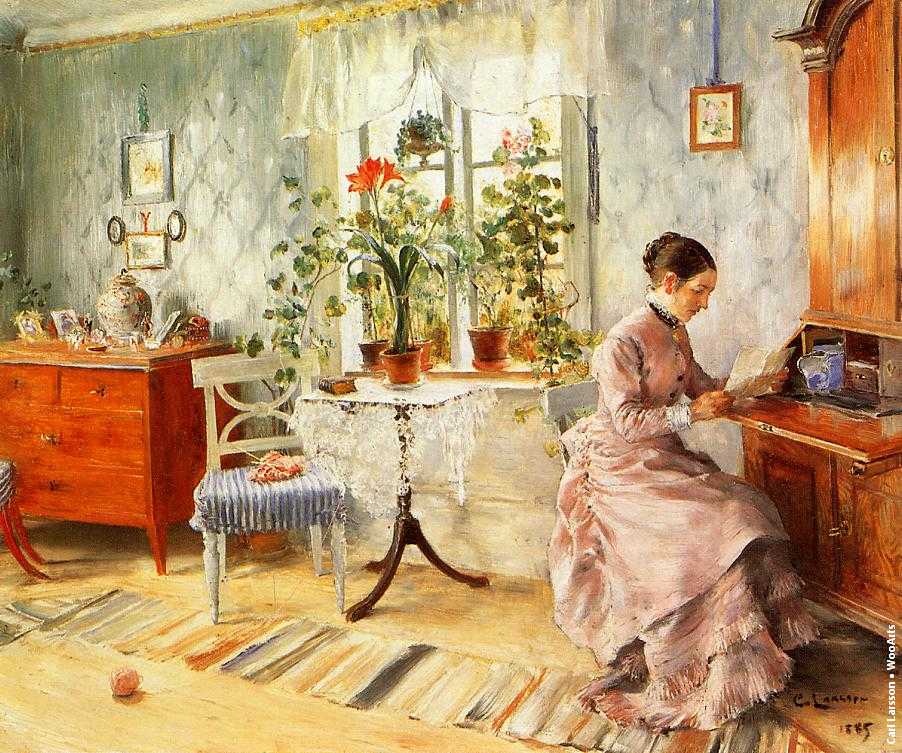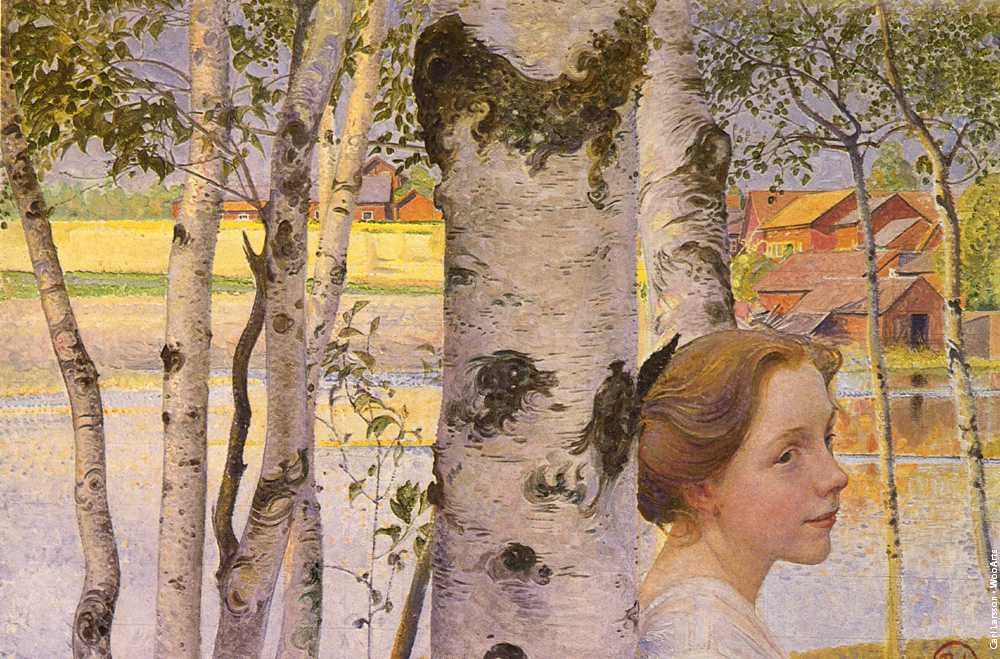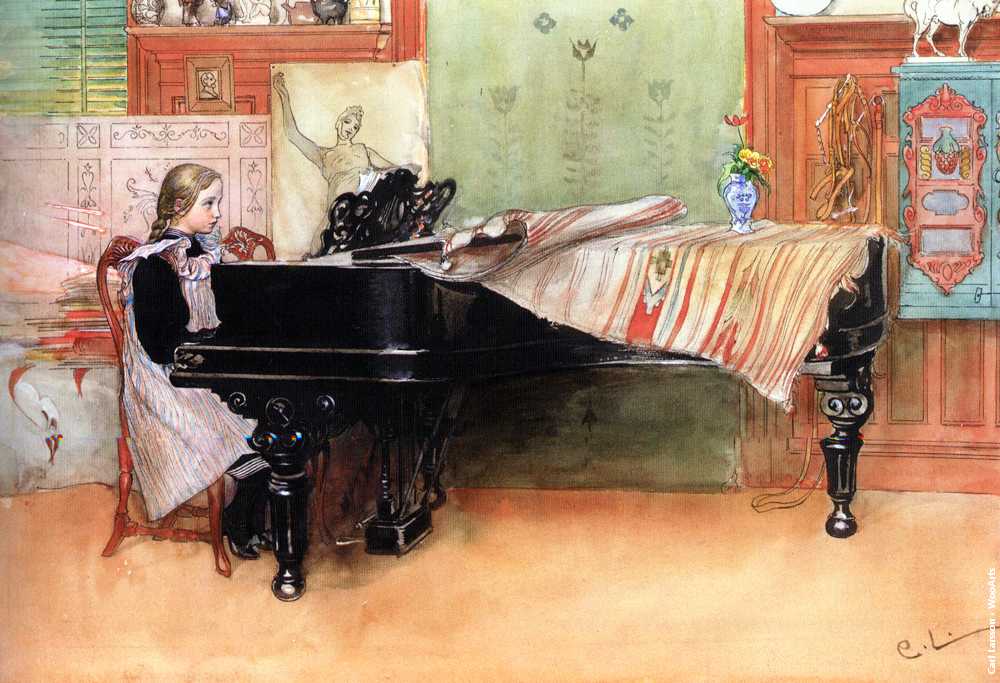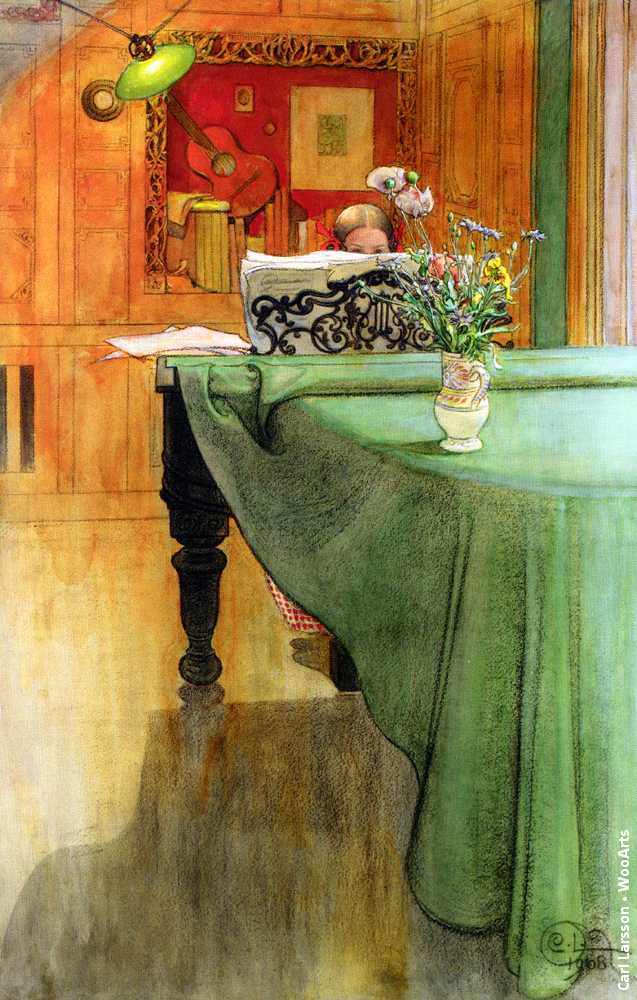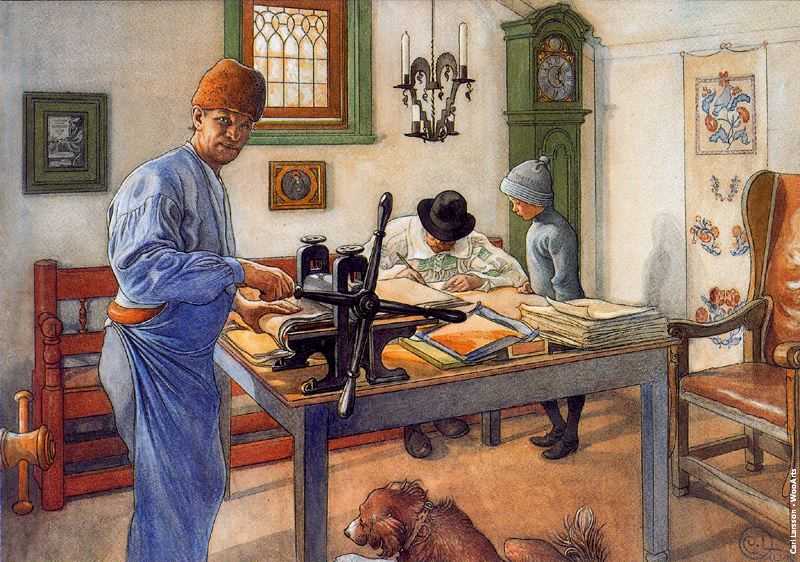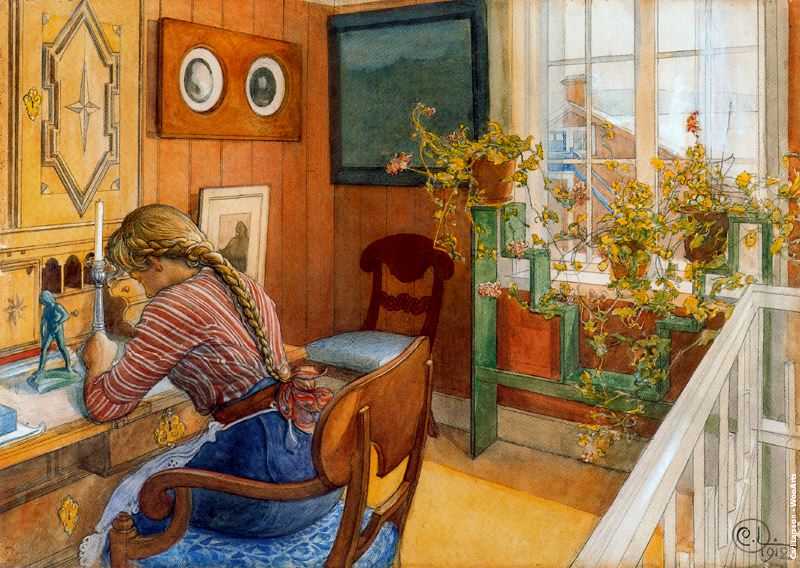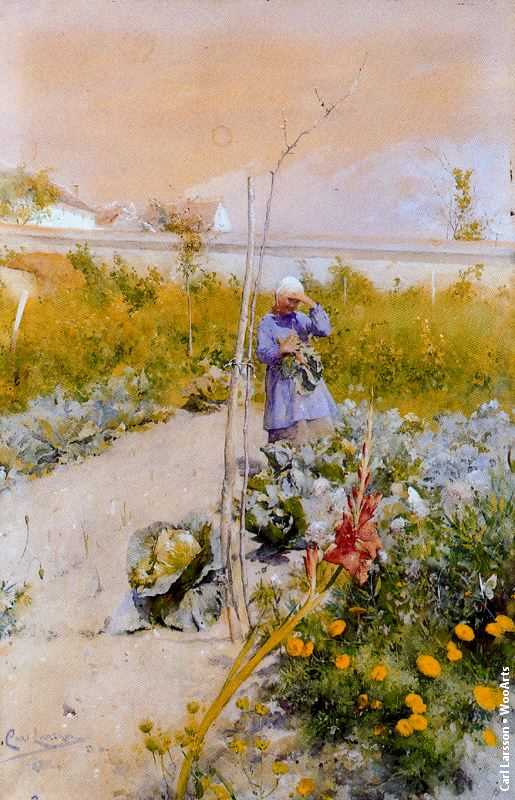(Swedish pronunciation: [ˈkɑːɭ ˈlɑ̌ːʂɔn] (audio speaker icon); 28 May 1853 – 22 January 1919)
One of Sweden’s most well loved artists through the ages
Carl Larsson was born in Gamla stan, the old quarter of Stockholm, on 28 May 1853. His family was poor and Carl grew up in dismal circumstances. The only glimmer of hope was his strong artistic talent, which emerged early on in his life. When he was thirteen years old his teacher at the school for the poor persuaded him to apply for a place at Principskolan, the preparatory department of the Art Academy.
During the first years at Principskolan Carl found it difficult to settle in. His sense of social inferiority made him feel like an outsider. But that changed when, at the age of sixteen, he was moved up to the lowest department of the Art Academy. He began to feel more confident and it was not long before he became one of the central figures in student circles.
Turning point in Grez-zur-Loing
After the Art Academy Carl worked at illustrating books, magazines and daily newspapers. He also spent several years in Paris where he tried to establish himself as an artist, but in spite of all his hard work he never achieved any success.
The turning point came in 1882 when he moved to the Scandinavian artists’ colony in Grez-zur-Loing outside Paris. It was there he met his future wife Karin Bergöö and underwent an artistic transformation after abandoning his pretentious oil painting in favour of watercolours – a lucky move that would mean a lot for his artistic development. It was in Grez-zur-Loing that he painted some of his most significant pictures.
Family life as a motif and source of inspiration
Carl and Karin were married in 1883 and had eight children. Karin and the children quickly became Carl’s favourite models.
In 1888 Karin’s father, Adolf Bergöö, gave them Lilla Hyttnäs, a small house in Sundborn. Lilla Hyttnäs became Carl och Karin’s mutual art project in which their artistic talents found expression in a very modern and personal architecture, colour scheme and interior design.
Carl’s paintings and books have made Lilla Hyttnäs one of the world’s most familiar homes. But not only that. The quality of the light, Karin’s liberated gift for interior design and the lively family life as it is depicted in Carl’s beloved watercolours, has become almost synonymous with our picture of Sweden.
The house still looks the same as it did when Carl and Karin lived there and today’s visitor to Lilla Hyttnäs can almost hear the animated laughter of the children and catch the scent of the artist’s oil paints.
View of his own artistic calling
It does not always happen that the view of the artist and the view of his public agree. In spite of the huge popular success he achieved with his watercolours Carl nevertheless felt that his monumental work – the frescoes in schools, museums and other public buildings, etc. – was more significant.
He was bitterly disappointed when his last monumental work, ”Midvinterblot”, which was to have adorned the east wall of the upper stairway in the National Museum i Stockholm, was refused by the committee.
In his memoirs, ”Jag” (published posthumously), he expressed his bitterness and disappointment over the opposition to the painting that he himself considered to be the pinnacle of his artistic achievement. He writes:
”The fate of Midvinterblot broke me! This I admit with subdued rage. Yet it was for the best – once again my intuition tells me that now – for this painting, with all its weaknesses, will be honoured with a far better place some day after I am gone.”
And we can only conclude that history proved him right in the end. Following its sale to a Japanese buyer, Midvinterblot was returned to the National Museum for the Carl Larsson-exhibition in 1992. With help from generous private donors the National Museum repurchased the work from its Japanese owner in 1997. Now, at last, it hangs where it was intended to be and Carl can rest easy in the knowledge that Midvinterblot has finally found its way home.
Biography
Early life and education
Larsson was born in the Gamla stan neighborhood of Stockholm, Sweden. His parents were extremely poor, and his childhood was not happy.
Renate Puvogel, in her book Carl Larsson (Cologne: Taschen; 1994), gives detailed information about Larsson’s life: “His mother was thrown out of the house, together with Carl and his brother Johan; after enduring a series of temporary dwellings, the family moved into Grev Magnigränd No. 7 (later No. 5) in what was then Ladugårdsplan, present-day Östermalm”. As a rule, each room was home to three families; “penury, filth and vice thrived there, leisurely seethed and smouldered, eaten-away and rotten bodies and souls. Such an environment is the natural breeding ground for cholera”, he wrote in his autobiographical novel Jag.
Larsson’s father worked as a casual laborer, sailed as a stoker on a ship headed for Scandinavia, and lost the lease to a nearby mill, only to work there later as a mere grain carrier. Larsson portrays him as a loveless man lacking self-control; he drank, ranted and raved, and incurred the lifelong anger of his son after an outburst in which he declared, “I curse the day you were born”. In contrast, Carl’s mother worked long hours as a laundress to provide for her family.
However, at the age of thirteen, his teacher at the school for poor children urged him to apply to the Royal Swedish Academy of Arts, and he was admitted. During his first years there, Larsson felt socially inferior, confused, and shy. In 1869, at the age of sixteen, he was promoted to the “antique school” of the same academy. There Larsson gained confidence, and even became a central figure in student life. Carl earned his first medal in nude drawing. In the meantime, Larsson worked as a caricaturist for the humorous paper Kasper and as a graphic artist for the newspaper Ny Illustrerad Tidning. His annual wages were sufficient to allow him to help support his parents financially.
Career
After several years working as an illustrator of books, magazines, and newspapers, Larsson moved to Paris in 1877, where he spent several frustrating years as a hardworking artist without any success. Larsson was not eager to establish contact with the French progressive Impressionists; instead, along with other Swedish artists, he cut himself off from the radical movement of change.
After spending two summers in Barbizon, the refuge of the plein-air painters, he settled down with his Swedish painter colleagues in 1882 in Grez-sur-Loing at a Scandinavian artists’ colony outside Paris. It was there that he met the artist Karin Bergöö (1859–1928), who soon became his wife. This was to be a turning point in Larsson’s life. In Grez, Larsson painted some of his most important works, now in watercolour and very different from the oil painting technique he had previously employed.
Carl and Karin Larsson had eight children (Suzanne (b. 1884), Ulf (b. 1887), Pontus (b. 1888), Lisbeth (b. 1891), Brita (b. 1893), Mats (b. 1894), Kersti (b. 1896) and Esbjörn (b. 1900). His family became Larsson’s favourite models. Many of the interiors depicted were the work of Karin Larsson, who also worked as an interior designer.
In 1888 the young family was given a small house named Little Hyttnäs at Sundborn just outside Falun in Dalarna by Karin’s father Adolf Bergöö (1828–1890). Carl and Karin decorated and furnished this house according to their particular artistic taste and also for the needs of the growing family. Through his paintings and books, Little Hyttnäs has become one of the most famous artist’s homes in the world, transmitting the artistic taste of its creators and making it a major line in Swedish interior design. The descendants of Carl and Karin Larsson now own this house, now known as Carl Larsson-gården, and keep it open for tourists each summer from May until October.
In his later years he suffered from bouts of depression. While working on Midvinterblot (1915), a large decoration for the vestibule of the Nationalmuseum, Larsson experienced the onset of an eye problem and a worsening of his frequent headaches. After suffering a mild stroke in January 1919, he spent his remaining time completing his memoirs. He died later that month in Falun and was buried in the cemetery of Sundborn Church (Sundborns kyrka).
Paintings
Larsson’s popularity increased considerably with the development of colour reproduction technology in the 1890s, when the Swedish publisher Bonnier published books written and illustrated by Larsson and containing full colour reproductions of his watercolours, titled A Home. However, the print runs of these rather expensive albums did not come close to that produced in 1909 by the German publisher Karl Robert Langewiesche (1874–1931). Langewiesche’s choice of watercolours, drawings and text by Carl Larsson, titled Das Haus in der Sonne (Königstein, Verlag Karl Robert Langewiesche. 1909), immediately became one of the German publishing industry’s best-sellers of the year—40,000 copies sold in three months, and more than 40 print runs have been produced up to 2001. Carl and Karin Larsson declared themselves overwhelmed by such success.
Carl Larsson considered his monumental works, such as his frescos in schools, museums and other public buildings, to be his most important works. His last monumental work, Midvinterblot (Midwinter Sacrifice), a 6-by-14-metre (20 ft × 46 ft) oil painting completed in 1915, had been commissioned for a wall in the National Museum in Stockholm (which already had several of his frescos adorning its walls). However, upon completion, it was rejected by the board of the museum. The fresco depicts the blót of King Domalde at the Temple of Uppsala. Decades later, the painting was purchased and placed in the National Museum.
Midvinterblot
Main article: Midvinterblot
In his memoirs Jag (Stockholm: Albert Bonniers förlag, 1931) – published after Larsson’s death – he declared his bitterness and disappointment over this rejection of the painting he himself considered to be his greatest achievement: “The fate of Midvinterblot broke me! This I admit with a dark anger. And still, it was probably the best thing that could have happened, because my intuition tells me – once again! – that this painting, with all its weaknesses, will one day, when I’m gone, be honoured with a far better placement.” Larsson admitted, however, in the same memoirs that the pictures of his family and home “became the most immediate and lasting part of my life’s work. For these pictures are of course a very genuine expression of my personality, of my deepest feelings, of all my limitless love for my wife and children.”
Fights between different schools of Swedish artists caused the “Midvinterblot” controversy to continue for many years. In 1987 the museum was even offered the monumental painting for free, provided it would adorn the empty wall for which it had been intended, but the museum declined the offer, so the painting was sold to the Japanese collector Hiroshi Ishizuka. In 1992, he agreed to lend it to the museum for its major Carl Larsson exhibition, where it was hung in the intended place. Public appreciation changed the experts’ view of the painting, and with the help of private donations the museum was able to buy it from Ishizuka in 1997 and permanently display it in the location for which it was intended.

View Carl Larsson Paintings
Source:
